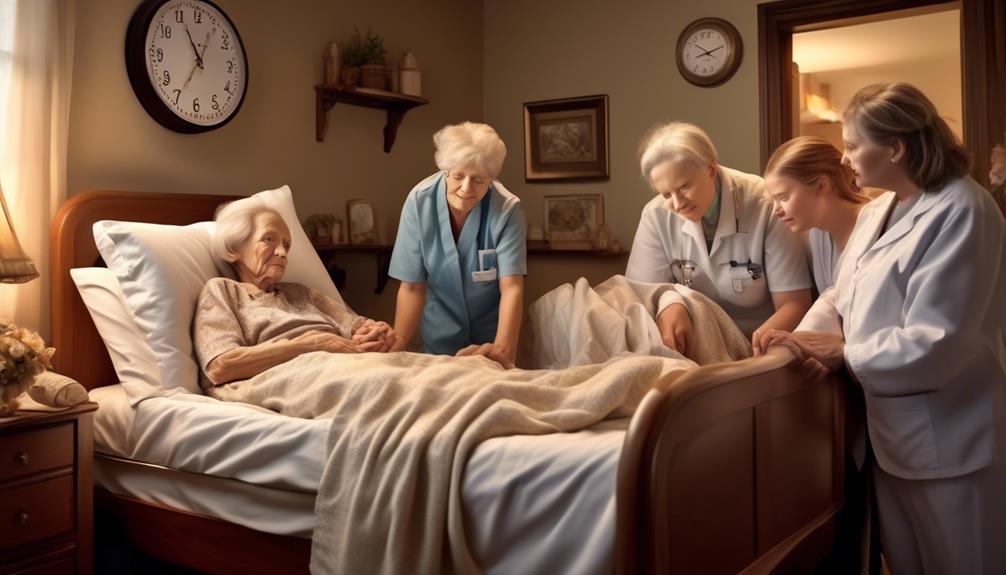Imagine yourself standing on the edge of a vast ocean, sensing the waves crashing against the shore in a steady, rhythmic manner. Similar to the constant ebb and flow of the ocean, our understanding of death fluctuates, sometimes overwhelming us completely.
But what if there was a way to navigate these turbulent waters and find a sense of peace amidst the uncertainty? Let's explore together how we can confront our fear of death, not as a daunting abyss, but as a profound opportunity for growth and acceptance.
Key Takeaways
- Practice mindfulness techniques like deep breathing for calmness.
- Engage in open discussions about death to reduce anxiety.
- Seek therapy for coping mechanisms and tools to address fears.
- Embrace steps to confront mortality with courage and purpose.
Understanding Fear of Death
Understanding the fear of death is a crucial step in addressing this common and complex human experience. Many people grapple with anxiety surrounding death, a natural part of life that can evoke extreme fear in some individuals. It's important to recognize that fear of death isn't inherently a sign of mental health disorders; rather, it's a deeply ingrained aspect of human existence. This fear can stem from various sources, such as concerns about dying alone, the unknown, or losing control.
Conversations about death, dying, and mortality are often avoided due to the discomfort they bring. However, seeking help, whether through therapy or supportive discussions, can be immensely beneficial for those struggling with the fear of death. Therapy can provide individuals with coping mechanisms, tools to address their anxiety, and a safe space to explore their feelings. By acknowledging and addressing these fears, individuals can work towards a healthier relationship with the concept of death.
Mindfulness Practices for Fear

Exploring mindfulness practices can offer valuable tools for individuals grappling with the fear of death, providing ways to stay present and alleviate anxiety surrounding mortality. Mindfulness techniques, such as deep breathing and body scans, can help individuals focus on the present moment, reducing worries about the future, including thoughts about death. Mindfulness meditation, a key practice in cultivating mindfulness, has been scientifically proven to decrease symptoms of anxiety and enhance overall mental well-being. By engaging in mindfulness regularly, individuals can build resilience and improve emotional regulation, enabling them to cope better with existential fears related to mortality. This enhanced ability to stay present and regulate emotions can reframe perspectives on death, fostering acceptance and peace of mind.
| Mindfulness Practices | Benefits |
|---|---|
| Deep breathing | Reduces anxiety and promotes relaxation |
| Body scans | Helps stay present and alleviate worries |
| Mindfulness meditation | Decreases anxiety symptoms and enhances well-being |
| Resilience building | Improves coping with existential fears |
| Emotional regulation | Enhances ability to manage fear of death |
Techniques to Alleviate Fear
To alleviate fear of death, consider implementing various techniques that can help manage and reduce feelings of anxiety and existential dread. Engaging in mindfulness techniques, such as deep breathing exercises, can calm the mind and provide a sense of peace when thoughts of mortality arise. Additionally, cognitive behavioral therapy (CBT) can be an effective way to reframe negative thoughts around mortality and cultivate a healthier relationship with life and death. For some, the fear of death and insomnia may be interconnected, as anxious thoughts about the unknown can disrupt the ability to fall asleep. Establishing a relaxing bedtime routine that incorporates mindfulness or calming activities can help ease both the fear of death and insomnia, promoting restful sleep.
Additionally, exposure therapy can be beneficial by gradually confronting fears related to death to desensitize the mind and reduce the intensity of the fear. Seeking professional therapy, like cognitive behavioral therapy, offers a structured approach to challenging and reframing negative thoughts surrounding death, creating a more positive outlook.
Exploring philosophical perspectives on mortality can also provide a new understanding and acceptance of the inevitable, helping individuals develop a healthy perspective on life and death. By focusing on gratitude, purpose, and engaging in meaningful activities, one can alleviate the fear of death and embrace life with a renewed sense of peace and acceptance.
Facing Mortality Head-On

Considering the inevitability of death as a natural part of life helps individuals confront their mortality head-on and gain a deeper understanding of its significance. When facing mortality, it's essential to embrace the following steps:
- Acknowledge and Acceptance: Acknowledge that death is an inevitable part of life and accepting this reality can help in easing fears surrounding mortality.
- Exploring Philosophical Beliefs: Reflecting on personal beliefs or philosophies about death can provide a broader perspective, leading to a more profound acceptance of the cycle of life.
- Open Discussions: Engaging in open discussions about death can help normalize the topic and reduce anxiety associated with it. Talking openly can also offer different viewpoints and insights.
- Mindfulness and Professional Help: Practice mindfulness to stay present and shift focus from fear of the future. Additionally, seeking professional therapy can assist in exploring underlying fears of death effectively and provide tools to cope with these fears.
Embracing Life With Courage
Confronting our mortality head-on can empower us to embrace life with courage, recognizing death as a natural part of our existence. By acknowledging our fear of death and actively working to understand and address it, we can unlock a deeper appreciation for the beauty and fragility of life. Developing resilience and inner strength plays a crucial role in this process, allowing us to confront our mortality with a sense of purpose and bravery. Through exposure therapy or talk therapy, individuals can navigate their anxieties surrounding death and find ways to live more fully in the present.
| Resilience | Inner Strength | Meaningful Relationships |
|---|---|---|
| Helps face fears | Provides courage | Reduces anxiety |
Engaging in activities that bring joy and fulfillment, focusing on positive aspects of life, and nurturing meaningful connections with others can all contribute to a life lived without the shadow of constant fear of death. Embracing life with courage requires a shift in perspective, but it can lead to mental health benefits and a more enriching existence.
Frequently Asked Questions
How Do You Overcome the Fear of Death?
We understand that overcoming the fear of death is a deeply personal journey. It involves introspection and acceptance of our mortality. By contemplating the nature of existence and our place in the universe, we can begin to ease our anxieties.
Embracing the impermanence of life and finding meaning in our experiences can help us navigate this fear. Remember, we're all on this journey together, seeking understanding and peace.
Why Am I Terrified of Death?
We're terrified of death because it challenges our understanding of existence and confronts us with the unknown. Traumatic events, loss, health issues, and a lack of purpose can intensify this fear.
Cultural and societal influences also play a role. To address this fear, seeking therapy or professional support can help uncover its roots and develop effective coping strategies.
It's essential to acknowledge and explore these feelings to find peace and acceptance.
How Do I Stop Panicking About Death?
When we're panicking about death, it's crucial to acknowledge our feelings and seek support.
Engaging in relaxation techniques like deep breathing and therapy can help reframe negative thoughts.
Gradual exposure to death-related triggers can build tolerance over time.
Medication may be an option for severe cases under professional guidance.
How Do I Find Peace With Death?
How do we find peace with death?
By acknowledging its inevitability and embracing the idea of living a meaningful life.
We can engage in mindfulness practices, seek comfort in spiritual beliefs, and focus on positive experiences.
Therapy or support groups can also help explore feelings about death.
Ultimately, by accepting death as a natural part of life and focusing on the present moment, we can cultivate a sense of peace and understanding.
Conclusion
In conclusion, by facing our fear of death head-on and embracing the transient nature of life, we can cultivate a sense of courage and acceptance. Through mindfulness practices, techniques to alleviate fear, and reframing our thoughts, we can gradually reduce our anxiety surrounding death.
By focusing on living positively and developing healthy coping mechanisms, we can work towards overcoming our fear of death and improving our mental well-being. Remember, in the face of fear, we've the power to find peace and strength within ourselves.









